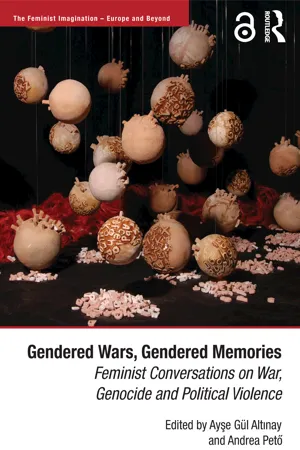
Gendered Wars, Gendered Memories
Feminist Conversations on War, Genocide and Political Violence
- 300 pages
- English
- ePUB (mobile friendly)
- Available on iOS & Android
Gendered Wars, Gendered Memories
Feminist Conversations on War, Genocide and Political Violence
About this book
The Introduction of this book is freely available as a downloadable Open Access PDF under a Creative Commons Attribution-Non Commercial-No Derivatives 4.0 license available at http://www.taylorfrancis.com/books/e/9781315584225
The twentieth century has been a century of wars, genocides and violent political conflict; a century of militarization and massive destruction. It has simultaneously been a century of feminist creativity and struggle worldwide, witnessing fundamental changes in the conceptions and everyday practices of gender and sexuality. What are some of the connections between these two seemingly disparate characteristics of the past century? And how do collective memories figure into these connections? Exploring the ways in which wars and their memories are gendered, this book contributes to the feminist search for new words and new methods in understanding the intricacies of war and memory. From the Italian and Spanish Civil Wars to military regimes in Turkey and Greece, from the Armenian genocide and the Holocaust to the wars in Abhazia, East Asia, Iraq, Afghanistan, former Yugoslavia, Israel and Palestine, the chapters in this book address a rare selection of contexts and geographies from a wide range of disciplinary perspectives. In recent years, feminist scholarship has fundamentally changed the ways in which pasts, particularly violent pasts, have been conceptualized and narrated. Discussing the participation of women in war, sexual violence in times of conflict, the use of visual and dramatic representations in memory research, and the creative challenges to research and writing posed by feminist scholarship, Gendered Wars, Gendered Memories will appeal to scholars working at the intersection of military/war, memory, and gender studies, seeking to chart this emerging territory with 'feminist curiosity'.
Frequently asked questions
- Essential is ideal for learners and professionals who enjoy exploring a wide range of subjects. Access the Essential Library with 800,000+ trusted titles and best-sellers across business, personal growth, and the humanities. Includes unlimited reading time and Standard Read Aloud voice.
- Complete: Perfect for advanced learners and researchers needing full, unrestricted access. Unlock 1.4M+ books across hundreds of subjects, including academic and specialized titles. The Complete Plan also includes advanced features like Premium Read Aloud and Research Assistant.
Please note we cannot support devices running on iOS 13 and Android 7 or earlier. Learn more about using the app.
Information
Part I: Commentary
"Disassemble the unthinkable to the unthought":1 Sexual Viloence Narrated
Table of contents
- Cover
- Half Title
- Series Page
- Title Page
- Copyright Page
- Table of Contents
- List of Figures
- Notes on Contributors
- Acknowledgements
- Foreword
- Introduction: Uncomfortable Connections: Gender, Memory, War
- PART I SEXUAL VIOLENCE: SILENCE, NARRATION, RESISTANCE
- PART II GENDERING MEMORIES OF WAR, SOLDIERING AND RESISTANCE
- PART III FICTIONALIZING AND VISUALIZING GENDERED MEMORIES
- PART IV FEMINIST REIMAGININGS
- Index